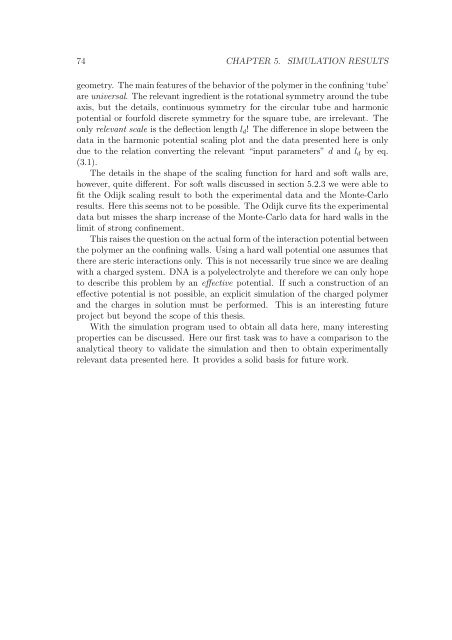Polymers in Confined Geometry.pdf
Polymers in Confined Geometry.pdf
Polymers in Confined Geometry.pdf
Create successful ePaper yourself
Turn your PDF publications into a flip-book with our unique Google optimized e-Paper software.
74 CHAPTER 5. SIMULATION RESULTS<br />
geometry. The ma<strong>in</strong> features of the behavior of the polymer <strong>in</strong> the conf<strong>in</strong><strong>in</strong>g ‘tube’<br />
are universal. The relevant <strong>in</strong>gredient is the rotational symmetry around the tube<br />
axis, but the details, cont<strong>in</strong>uous symmetry for the circular tube and harmonic<br />
potential or fourfold discrete symmetry for the square tube, are irrelevant. The<br />
only relevant scale is the deflection length ld! The difference <strong>in</strong> slope between the<br />
data <strong>in</strong> the harmonic potential scal<strong>in</strong>g plot and the data presented here is only<br />
due to the relation convert<strong>in</strong>g the relevant “<strong>in</strong>put parameters” d and ld by eq.<br />
(3.1).<br />
The details <strong>in</strong> the shape of the scal<strong>in</strong>g function for hard and soft walls are,<br />
however, quite different. For soft walls discussed <strong>in</strong> section 5.2.3 we were able to<br />
fit the Odijk scal<strong>in</strong>g result to both the experimental data and the Monte-Carlo<br />
results. Here this seems not to be possible. The Odijk curve fits the experimental<br />
data but misses the sharp <strong>in</strong>crease of the Monte-Carlo data for hard walls <strong>in</strong> the<br />
limit of strong conf<strong>in</strong>ement.<br />
This raises the question on the actual form of the <strong>in</strong>teraction potential between<br />
the polymer an the conf<strong>in</strong><strong>in</strong>g walls. Us<strong>in</strong>g a hard wall potential one assumes that<br />
there are steric <strong>in</strong>teractions only. This is not necessarily true s<strong>in</strong>ce we are deal<strong>in</strong>g<br />
with a charged system. DNA is a polyelectrolyte and therefore we can only hope<br />
to describe this problem by an effective potential. If such a construction of an<br />
effective potential is not possible, an explicit simulation of the charged polymer<br />
and the charges <strong>in</strong> solution must be performed. This is an <strong>in</strong>terest<strong>in</strong>g future<br />
project but beyond the scope of this thesis.<br />
With the simulation program used to obta<strong>in</strong> all data here, many <strong>in</strong>terest<strong>in</strong>g<br />
properties can be discussed. Here our first task was to have a comparison to the<br />
analytical theory to validate the simulation and then to obta<strong>in</strong> experimentally<br />
relevant data presented here. It provides a solid basis for future work.













